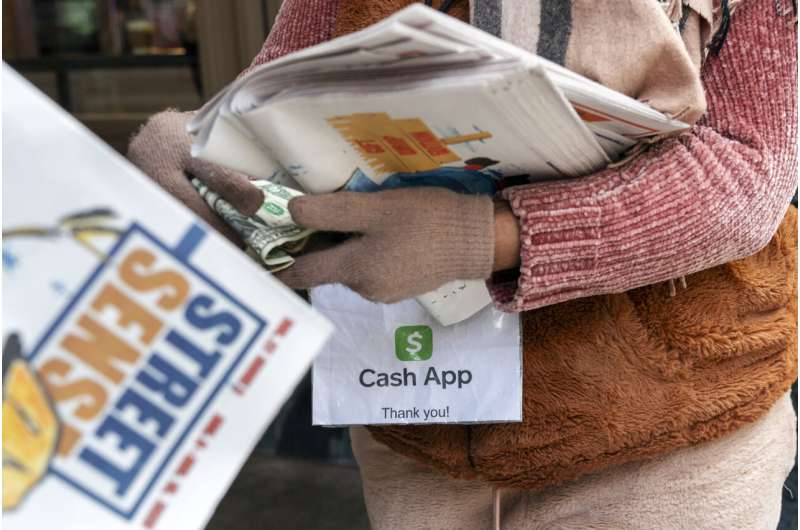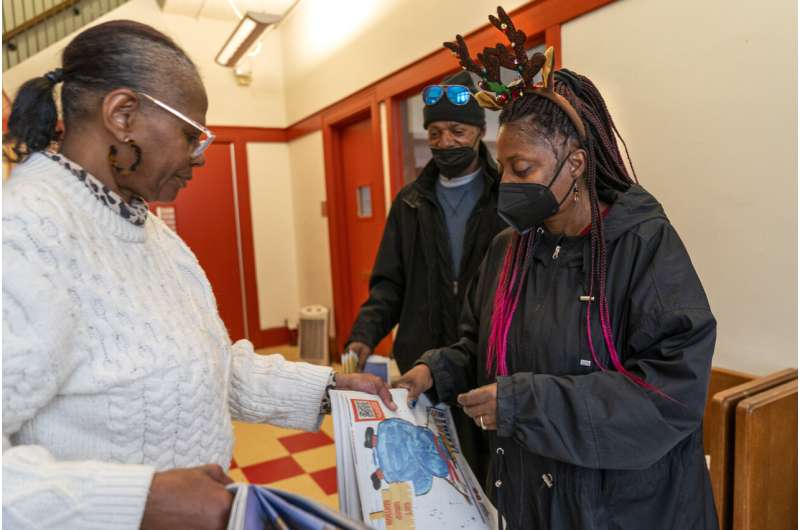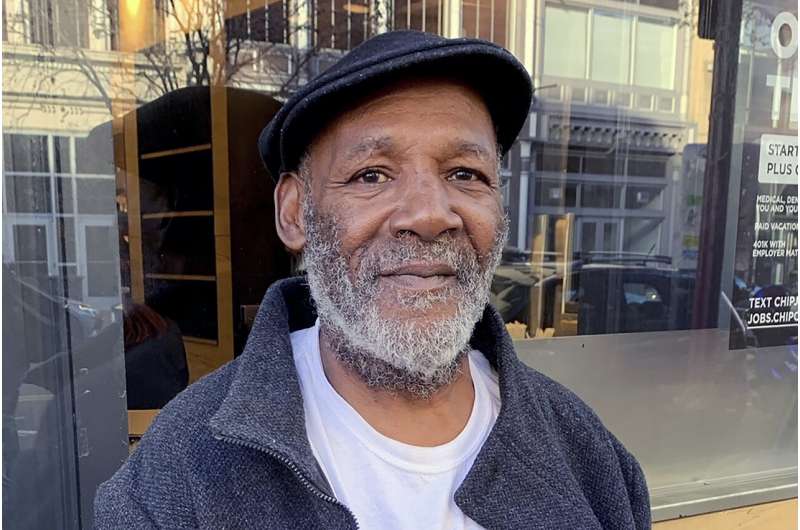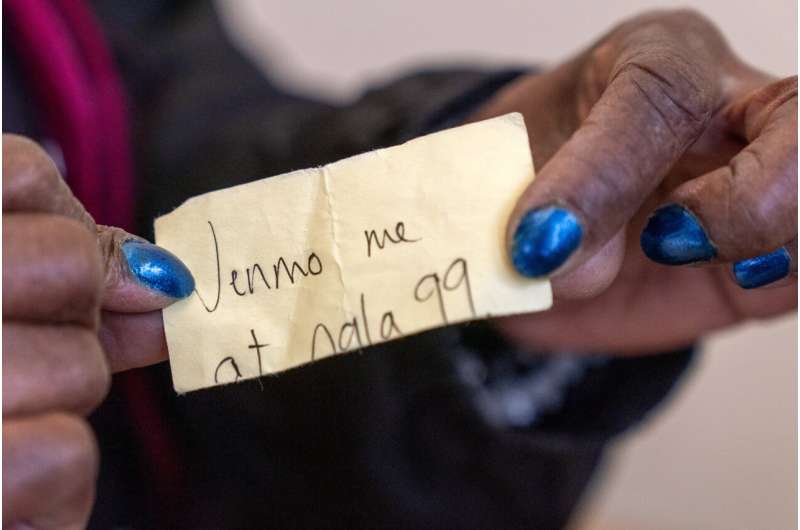
John Littlejohn remembers the days when lots of people had a couple of dollars to spare to buy a copy of Street Sense, the local paper that covers issues related to the homeless and employs unhoused individuals as its vendors.
Today, he’s finding fewer people are walking around with spare change. Even well-meaning individuals who want to help are likely to pat their pockets and apologize, he said.
“I would be out here for six or seven hours and wouldn’t get more than $12 to $15,” said Littlejohn, 62, who was homeless for 13 years. “People are like, ‘I don’t leave the house with cash.'”
But just as technological shifts helped create the problem, further advances are now helping charitable groups and advocates for the unhoused reach those most in danger of being left behind in a cashless society.
A special Street Sense phone app allows people to buy a copy electronically and have the profits go straight to him. Thanks to Social Security and his income from Street Sense and other side gigs, Littlejohn now has his own apartment.
One of the larger shifts in Western society over the past two decades has been the decline of cash transactions. It started with more people using credit cards to pay for things as trivial as a cup of coffee. It accelerated as smartphone technology advanced to the point where cash-free payments became the norm for many.
This shift has been felt keenly in the realm of street-level charitable giving—from individual donations to panhandlers and street musicians to the red Salvation Army donation kettles outside grocery stores.

“Everybody just has cards or their phones now,” said Sylvester Harris, a 54-year-old Washington native who panhandles near Capital One Arena. “You can tell the ones who really do want to help you, but even they just don’t have cash anymore.”
The cashless world can be particularly daunting for the unhoused. While electronic payment apps such as PayPal or Venmo have become ubiquitous, many of these options require items beyond their reach—credit cards, bank accounts, identification documents or fixed mailing addresses.
Charities have struggled to adapt. The Salvation Army has created a system where donors can essentially tap their phones on the kettle and pay directly.
Michelle Wolfe, director of development for the Salvation Army in Washington, said the new system is only in place in 2% of the collection kettles in the greater Washington area, but it has already resulted in increased donations. The minimum cashless donation is now $5, and donors routinely go as high as $20, Wolfe said.
At Street Sense, similar advances were necessary to keep up with changing consumer habits. Around 2013, executive director Brian Camore said he started receiving “anecdotal reports left and right” from vendors saying people wanted to buy a copy but had no cash. Each vendor purchases the copies from Street Sense for 50 cents and sells them for $2.
“We were losing sales and had to do something about it,” he said. “We recognized that the times were changing, and we had to change with them.”
Eventually he heard about an affiliate paper in Vancouver that had developed a cashless payment app and licensed the technology. Vendors can now redeem their profits at the Street Sense offices.

Thomas Ratliff, Street Sense’s director of vendor employment, deals directly with the paper’s approximately 100 sellers. He cited the COVID-19 pandemic as an extra factor making life difficult for his team.
For starters, it scared people away from using cash for fear that paper money exchanges would be an infection vector. But the most damaging part was the permanent reduction in the number of people working from downtown offices, cutting off Street Sense’s main customer base.
“Commuters have always been the best customers compared to tourists,” he said.
But without that steady stream of familiar commuters, Ratliff said his vendors have had to expand their territory. Instead of concentrating on the downtown business district, Street Sense vendors now often travel by Metro to places like Silver Spring, Maryland, to find commercial areas with steady foot traffic.
Ratliff now finds himself doing tech support for his vendors, helping them navigate the complexities of a modern online presence. Among the most common problems: “Changing emails, losing or forgetting passwords, losing your documents.”
Certain payment platforms like Venmo and Cash App are more unhoused-friendly because they do not require a bank account, just a phone number and email address. But even that can be daunting. Ratliff said many of his vendors often change cellphone numbers, and a steady phone number can be a key element in verifying your identity on these apps.
Others have taken the technology a step further, developing apps that aim to not only enable cashless donations to the homeless but also to steer them into support systems that can help get them off the streets. The Samaritan app takes a deeply personal approach by allowing donors to essentially help sponsor an unhoused person without using cash.

Currently operating in seven cities, including Los Angeles and Baltimore, the program distributes special cards to unhoused people containing a QR code that enables individuals to donate directly to someone’s account. The app itself contains dozens of mini-profiles of local unhoused individuals describing their situation and immediate needs. Donors can give money to fund specific needs, from groceries or a deposit on an apartment to clothing suitable for a job interview.
“It’s a lot harder to walk by someone when you know even 1% of their story,” said Jon Kumar, the Samaritan app’s founder. “It personalizes the person in need—their personality and the tangible specificity of their needs and goals.”
Kumar licenses his app technology to charities, and recipients can redeem their donations by meeting with a case manager—which serves as a route to provide other services like counseling or drug rehab. In addition to the direct donations, recipients can also receive $10 or $20 bonuses for reaching certain benchmarks, such as meeting with a case manager, submitting a job application or even reaching out to an estranged family member.
“No one is going to pay their rent through street donations. But if our platform helps a person press into their housing search, their employment search, their pursuit of recovery, those types of things are a lot more impactful,” Kumar said.
These efforts to transcend the cashless technology gap have seen their share of trial and error over the years. Wolfe said the Salvation Army originally tried out a system using a QR code that proved to be “too clunky and took too long.”
Kumar’s early efforts included an experiment with giving unhoused people Bluetooth beacon devices that enabled app users to see which beacon holders were in their area and donate to them. But the beacons needed regular battery changes, and the model was eventually abandoned.
None of these solutions is perfect, and plenty of people are still being left behind. Ratliff said many people simply don’t have the temperament or personality for the job.

“You have to have nerve to sell a paper and reel in customers,” he said. Others are disabled or frail and “not up for the physical stresses of selling out there.”
Kumar, the Samaritan app developer, said many unhoused people “are not a great fit for this kind of intervention.”
Some have deeper mental or emotional issues that make the level of structure required by the program impossible to navigate.
“Many of the people we’re trying to serve are in need of more intensive, perhaps permanent support in terms of their mental health,” he said. “Those folks, because of the polychronic nature of their challenges, they’re constantly left behind.”
© 2023 The Associated Press. All rights reserved. This material may not be published, broadcast, rewritten or redistributed without permission.
Citation:
Technology built the cashless society. Advances are helping the unhoused so they’re not left behind (2023, December 9)
retrieved 10 December 2023
from https://techxplore.com/news/2023-12-technology-built-cashless-society-advances.html
This document is subject to copyright. Apart from any fair dealing for the purpose of private study or research, no
part may be reproduced without the written permission. The content is provided for information purposes only.
Stay connected with us on social media platform for instant update click here to join our Twitter, & Facebook
We are now on Telegram. Click here to join our channel (@TechiUpdate) and stay updated with the latest Technology headlines.
For all the latest Technology News Click Here
For the latest news and updates, follow us on Google News.
